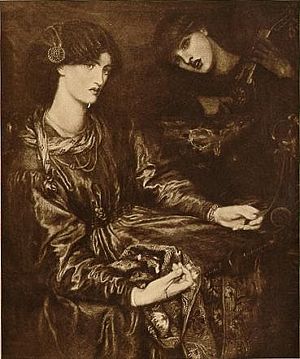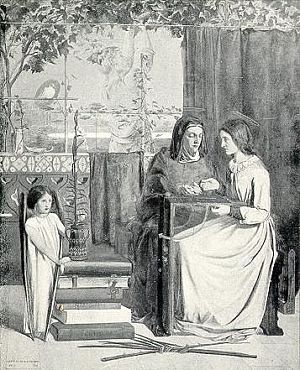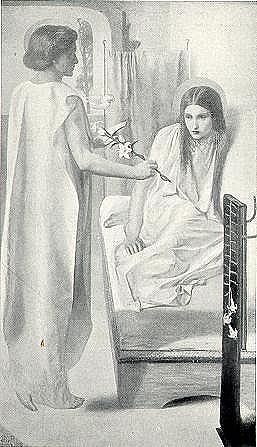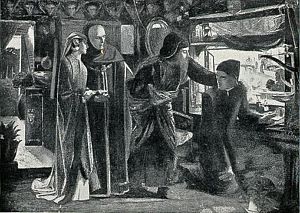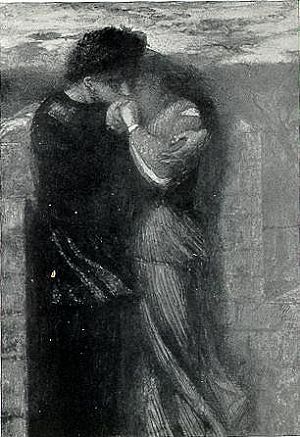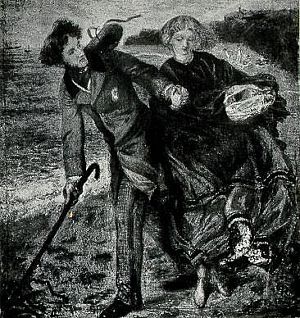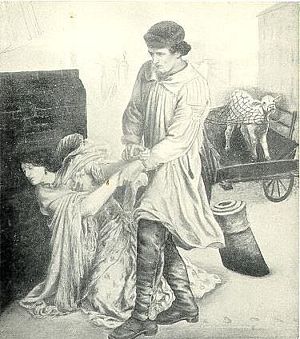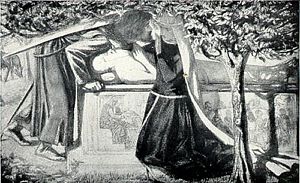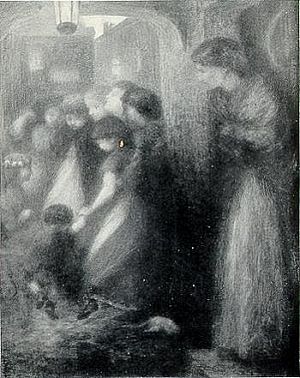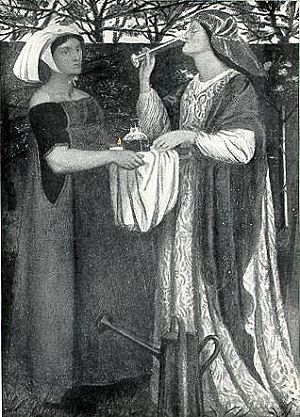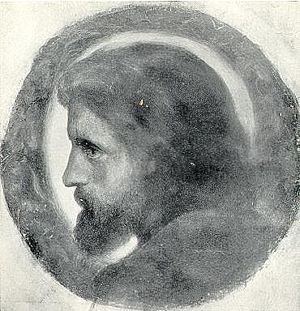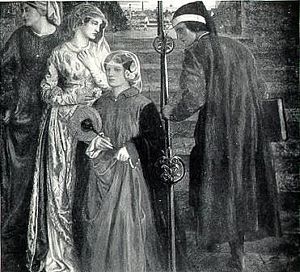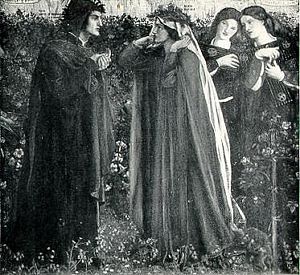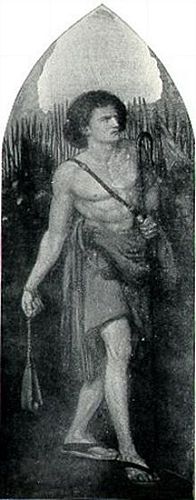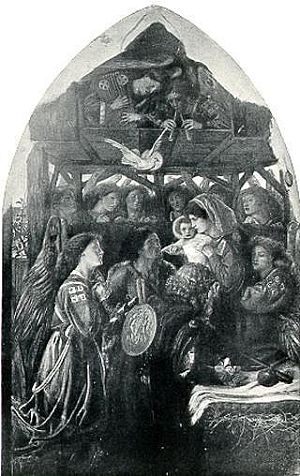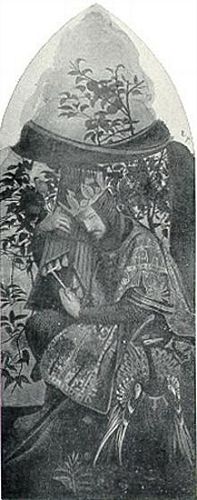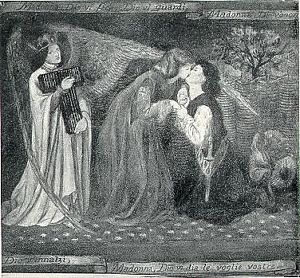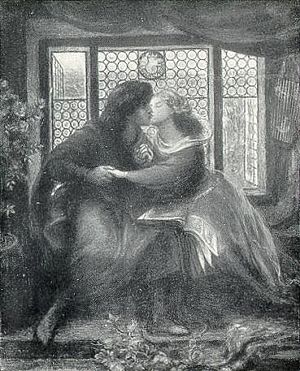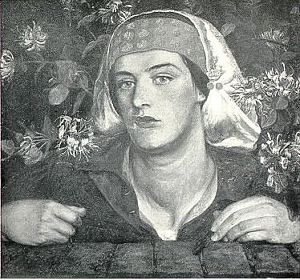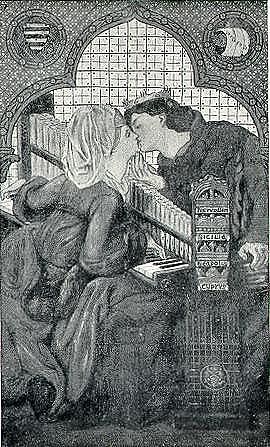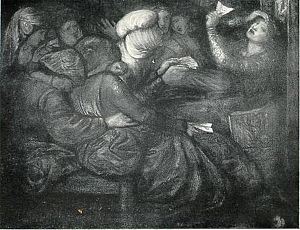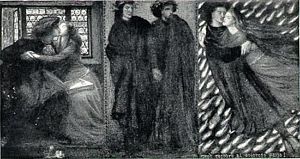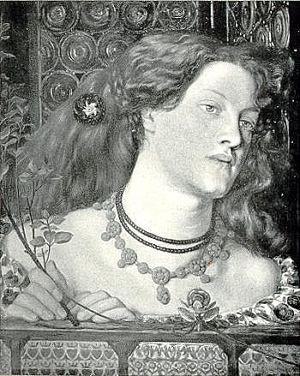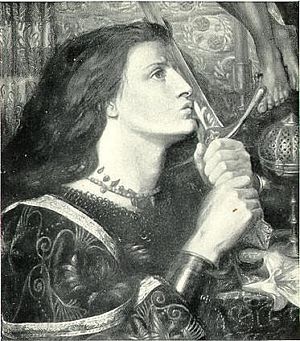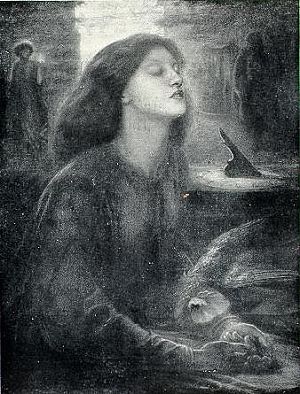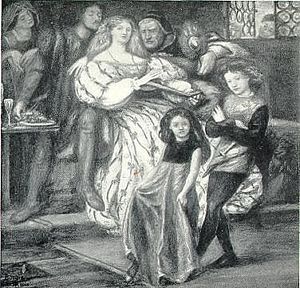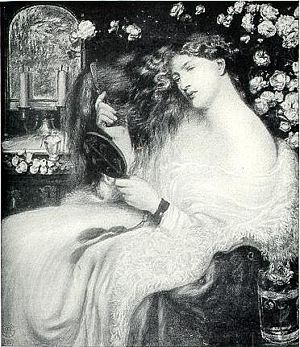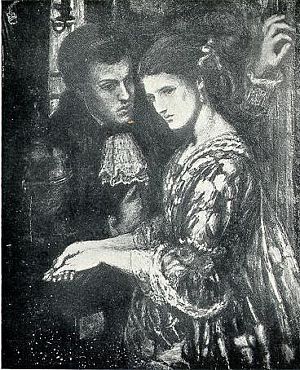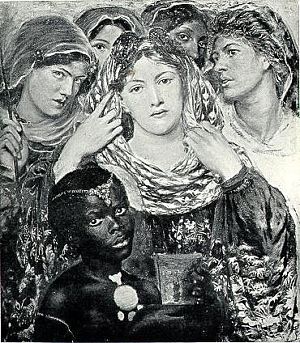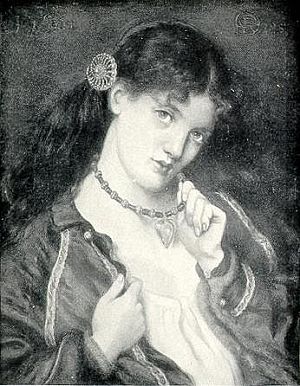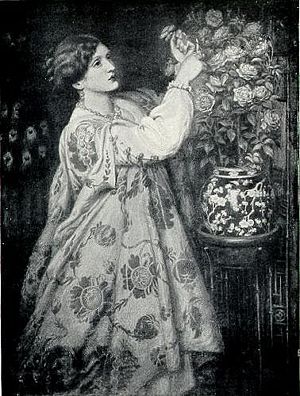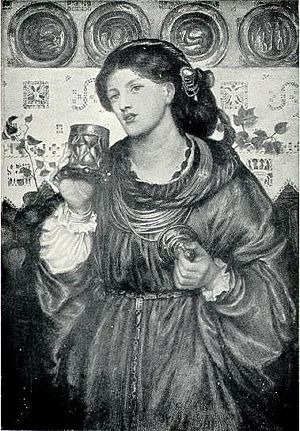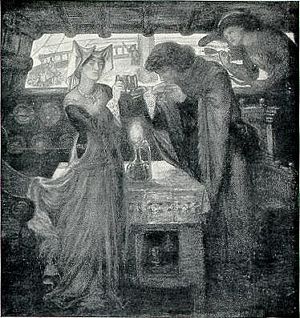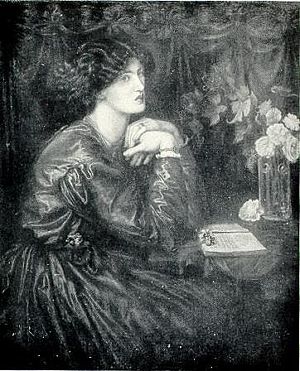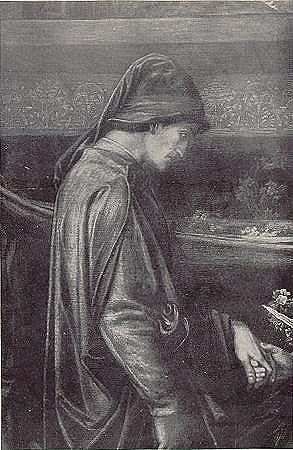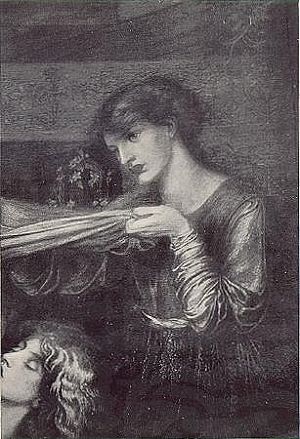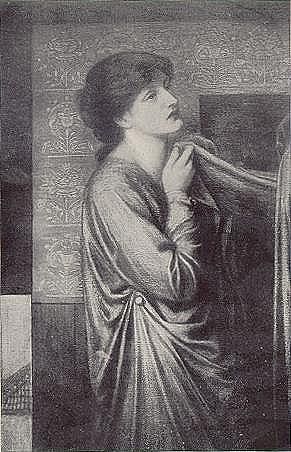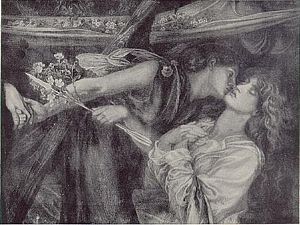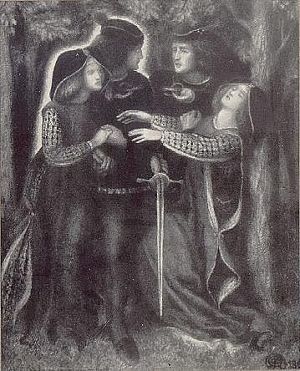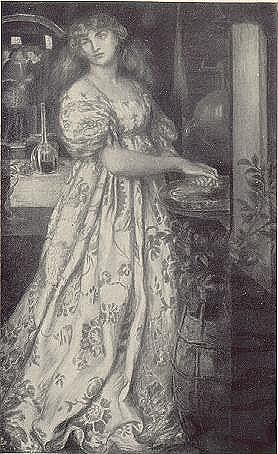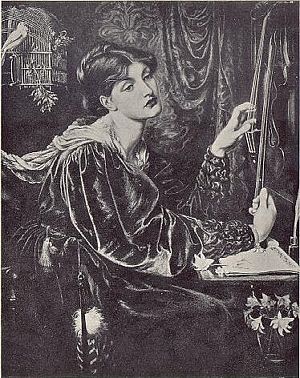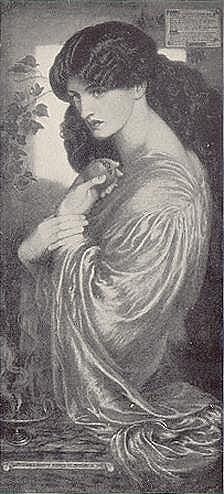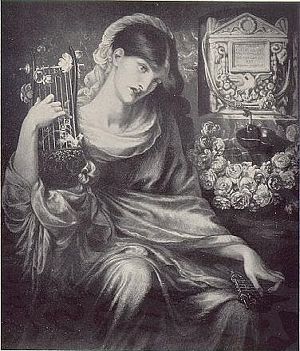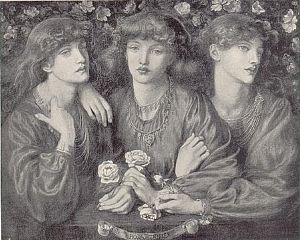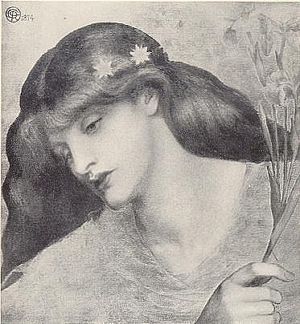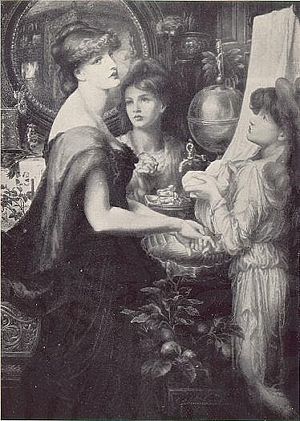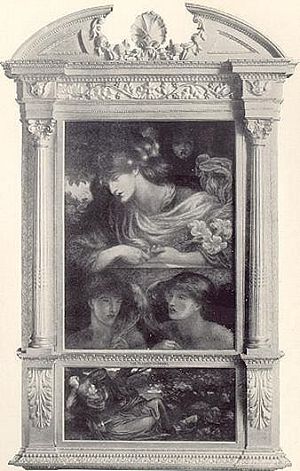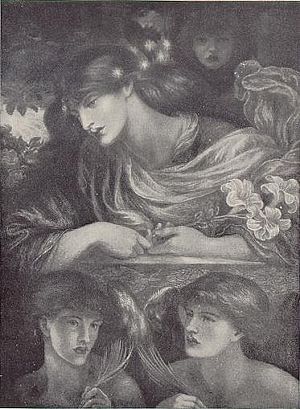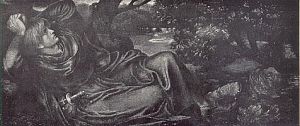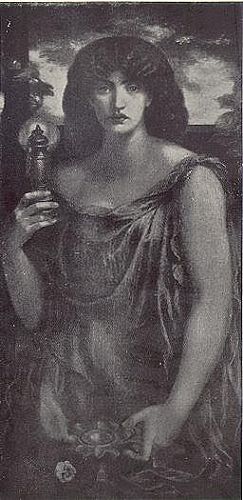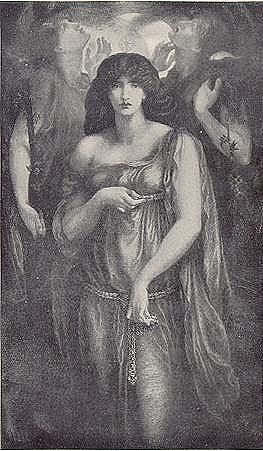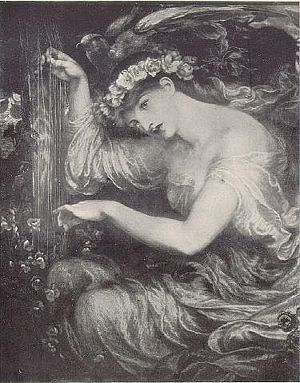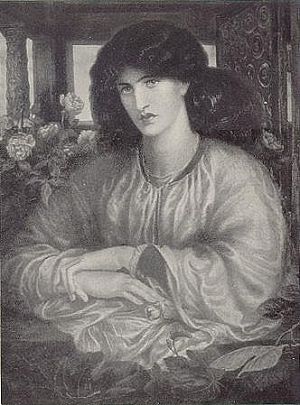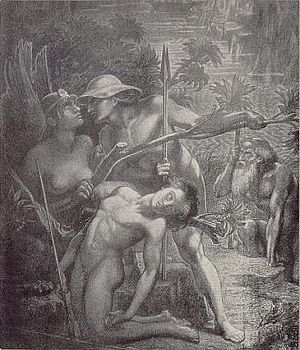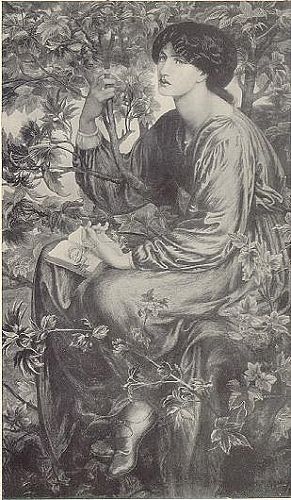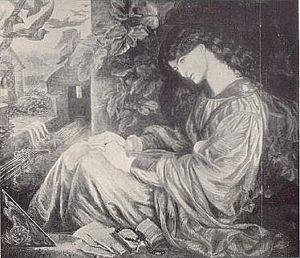Rossetti Archive Textual Transcription
Document Title: Dante Gabriel Rossetti
Author: Ernest Radford
Date of publication: 1905
Publisher: George Newnes Limited
Printer: Ballantyne & Co, Ltd. at the Ballantyne Press
Edition: 1
The full Rossetti Archive record for this transcribed document is available.
Editorial Note (page ornament): Newnes' Art Library ornament
ROSSETTI
Note: Blank page.
Editorial Note (page ornament): Publishers' ornament depicting three cupids, center of page.
ROSSETTI
LONDON: GEORGE NEWNES LIMITED
SOUTHAMPTON STREET STRAND WC
NEW YORK: FREDERICK WARNE & CO 36 EAST 22 nd ST.
THE BALLANTYNE PRESS
TAVISTOCK ST. LONDON
-
LIST OF ILLUSTRATIONS
- Mariana. . . . . . . . . . . . Frontispiece
- Girlhood of Mary Virgin. . . . . . . . . . . . 1
- Ecce Ancilla Domini. . . . . . . . . . . . . 2
- Dante drawing the Angel. . . . . . . . . . . . 3
- Carlisle Tower. . . . . . . . . . . . . . 4
- The Writing on the Sand. . . . . . . . . . . . 5
- Found. . . . . . . . . . . . . . . . 6
- King Arthur's Tomb. . . . . . . . . . . . . 7
- The Gate of Memory. . . . . . . . . . . . . 8
- The Bower Garden. . . . . . . . . . . . . 9
- Head of Christ. . . . . . . . . . . . . . 10
- The Salutation of Beatrice in Florence. . . . . . . . . 11
- The Salutation of Beatrice in Paradise. . . . . . . . . 12
- David the Shepherd; from the Triptych, Llandaff Cathedral . . . . .13
- The Nativity; Centre piece of the Triptych, Llandaff Cathedral . . . . 14
- David the King; from the Triptych, Llandaff Cathedral . . . . . . 15
- Love's Greeting. . . . . . . . . . . . . . 16
- Francesca da Rimini. . . . . . . . . . . . . 17
- Burd Alane. . . . . . . . . . . . . . .18
- Music—King Rene's Honeymoon . . . . . . . . . . 19
- St. George—the Princess drawing the Fatal Lot . [.] . . . . . 20
- Paolo and Francesca. . . . . . . . . . . . . 21
- Fair Rosamond. . [.] . . . . . . . . . . . 22
- Joan of Arc. . . . . . . . . . . . . . . 23
- Beata Beatrix. . . . . . . . . . . . . . 24
- Borgia Family. . . . . . . . . . . . . . 25
- Lady Lilith. . . . . . . . . . . . . . . 26
- Washing hands. . . . . . . . . . . . . . 27
- The Beloved. . . . . . . . . . . . . . 28
- Joli Cœur. . . . . . . . . . . . . . . 29
- Monna Rosa. . . . . . . . . . . . . . 30
- The Loving Cup. . . . . . . . . . . . . . 31
- Sir Tristram and La Belle Yseult. . . . . . . . . . 32
- Mrs. William Morris. . . . . . . . . . . . . 33
- Dante's Dream. . . . . . . . . . . . . . 34
- Portion, Dante's Dream. . . . . . . . . . . . 35
-
LIST OF ILLUSTRATIONS—
continued
- Portion, Dante's Dream. . . . . . . . . . . . 36
- Portion, Dante's Dream. . . . . . . . . . . . 37
- Portion, Dante's Dream. . . . . . . . . . . . 38
- How they met themselves. . . . . . . . . . . . 39
- Lucretia Borgia. . . . . . . . . . . . . . 40
- Veronica Veronese. . . . . . . . . . . . . 41
- Proserpine. . . . . . . . . . . . . . . 42
- A Roman Widow. . . . . . . . . . . . . 43
- Rosa Triplex. . . . . . . . . . . . . . 44
- The Blessed Damozel. . . . . . . . . . . . . 45
- La Bella Mano. . . . . . . . . . . . . . 46
- The Blessed Damozel. . . . . . . . . . . . . 47
- The Blessed Damozel (Detail). . . . . . . . . . . 48
- The Blessed Damozel (Detail). . . . . . . . . . . 49
- The Lamp of Memory. . . . . . . . . . . . 50
- Astarte Syriaca. . . . . . . . . . . . . . 51
- The Sea Spell. . . . . . . . . . . . . . 52
- La donna della Finestra. . . . . . . . . . . . 53
- The Sphinx. . . . . . . . . . . . . . . 54
- The Day Dream. . . . . . . . . . . . . . 55
- La Pia. . . . . . . . . . . . . . . . 56
Editorial Note (page ornament): Page header depicting four cupids, with scrolls. Ornamented capital N
begins text.
N0 artist entirely of the last century has had so much
written about him as Rossetti, so the trouble is with
the superabundance rather than the paucity of the
material, and attempting within the limits of space,
to give not only the main facts of his life once more,
but to pay the tribute of an Art-lover to Genius, is
in reality very much harder than it would be to write
at great length.
written about him as Rossetti, so the trouble is with
the superabundance rather than the paucity of the
material, and attempting within the limits of space,
to give not only the main facts of his life once more,
but to pay the tribute of an Art-lover to Genius, is
in reality very much harder than it would be to write
at great length.
Between certain young writers in the year of Rossetti's death, there
was a most spirited race from Birchington where the dead lay to the
nearest publishing houses, and their books stood alone for some time.
Then came one in the “Great Writers” series, the author of which, Mr.
Joseph Knight, took Rossetti's poetical works as his main subject. To
books must be added the articles which have flowed like a stream through
the press, but of the man as we know him now, there was little in the
biographies published before the appearance in 1892 of Wm. Bell Scott's
“Autobiography,” which made a great stir in its day; so great that the
consequence was the immediate call for more to which Wm. Rossetti
responded in 1895 with the “Memoirs and Family Letters” of his late
brother. “He would be wrongly described,” said the writer, “as a
sentimentalist, a dreamer, and æsthete, and the like, without making allow-
ance on the other side for attributes of a very opposite character, for the
fact is that he was full of buoyancy, vigour, élan; well-alive to the main
chance, capable of enjoying the queer as well as the graver aspects of life;
and whatever else he may have been, a quick-blooded, straight-speaking
man who hated nothing so much as humbug,” and was extraordinarily
quick to detect it. These desirable masculine traits are not very com-
monly found with the emotional and intellectual characteristics of poets,
but Rossetti was started in life with them all : as prone at the age of eighteen to make the most impious jokes, as to paint, or compose his
poems.
was a most spirited race from Birchington where the dead lay to the
nearest publishing houses, and their books stood alone for some time.
Then came one in the “Great Writers” series, the author of which, Mr.
Joseph Knight, took Rossetti's poetical works as his main subject. To
books must be added the articles which have flowed like a stream through
the press, but of the man as we know him now, there was little in the
biographies published before the appearance in 1892 of Wm. Bell Scott's
“Autobiography,” which made a great stir in its day; so great that the
consequence was the immediate call for more to which Wm. Rossetti
responded in 1895 with the “Memoirs and Family Letters” of his late
brother. “He would be wrongly described,” said the writer, “as a
sentimentalist, a dreamer, and æsthete, and the like, without making allow-
ance on the other side for attributes of a very opposite character, for the
fact is that he was full of buoyancy, vigour, élan; well-alive to the main
chance, capable of enjoying the queer as well as the graver aspects of life;
and whatever else he may have been, a quick-blooded, straight-speaking
man who hated nothing so much as humbug,” and was extraordinarily
quick to detect it. These desirable masculine traits are not very com-
monly found with the emotional and intellectual characteristics of poets,
but Rossetti was started in life with them all : as prone at the age of eighteen to make the most impious jokes, as to paint, or compose his
poems.
But with humour there was solicitude always, and whether as critic
of writings by brother and sister, or their adviser on other occasions,
he never spared trouble at all. What the reader will notice in the majority
of the home letters is their simplicity, and the sanity of his advice. As for
“moods,” he had his share of them, but remembering that Rossetti,
besides being one of ourselves, was “in the essence of his mind and
temperament,” both poet and artist in one, the wonder will seem to be not
that the balance of parts in a mind so strangely composed was upset, but
that it was maintained so long. Nowhere do we seem so near to the
Rossetti who lives in Art as in Lady Burne-Jones's lately published Life of
her husband wherein the names of Rossetti, Morris, and Jones occur more
frequently than any others. “I wish,” she says, “it were possible to
explain the impression made upon me as a young girl whose experience
had so far been quite remote from Art, by sudden and close intercourse
with those to whom it was the breath of life. The only approach I can
make to it, is by saying that I felt the presence of a new religion.” There
is more to the same effect than can be quoted, and in the particular case
of Rossetti there is evidence from all quarters of the strength of the hold
which his genius gave him over others. “In these first years,” said
Burne-Jones, “I never wanted to think but as he thought, and in the
miserable ending years of his life, I never forgot this image of him in his
prime, and upbraided the fate that could change him.” “Rossetti
was the planet round which we revolved,” said Mr. Prinsep in his account
of the Oxford days. The picture I have in my mind has been formed
as the reader will see, by comparing the impressions of those who actually
knew the man, or by accident of birth or marriage were drawn into the
circle to which he belonged. One such is Helen M. M. Rossetti , who
says : “I have purposely laid stress on Rossetti's possession in very full
measure of humour because of its infinite value to the possessor in as
much as he is an artist at all.”
of writings by brother and sister, or their adviser on other occasions,
he never spared trouble at all. What the reader will notice in the majority
of the home letters is their simplicity, and the sanity of his advice. As for
“moods,” he had his share of them, but remembering that Rossetti,
besides being one of ourselves, was “in the essence of his mind and
temperament,” both poet and artist in one, the wonder will seem to be not
that the balance of parts in a mind so strangely composed was upset, but
that it was maintained so long. Nowhere do we seem so near to the
Rossetti who lives in Art as in Lady Burne-Jones's lately published Life of
her husband wherein the names of Rossetti, Morris, and Jones occur more
frequently than any others. “I wish,” she says, “it were possible to
explain the impression made upon me as a young girl whose experience
had so far been quite remote from Art, by sudden and close intercourse
with those to whom it was the breath of life. The only approach I can
make to it, is by saying that I felt the presence of a new religion.” There
is more to the same effect than can be quoted, and in the particular case
of Rossetti there is evidence from all quarters of the strength of the hold
which his genius gave him over others. “In these first years,” said
Burne-Jones, “I never wanted to think but as he thought, and in the
miserable ending years of his life, I never forgot this image of him in his
prime, and upbraided the fate that could change him.” “Rossetti
was the planet round which we revolved,” said Mr. Prinsep in his account
of the Oxford days. The picture I have in my mind has been formed
as the reader will see, by comparing the impressions of those who actually
knew the man, or by accident of birth or marriage were drawn into the
circle to which he belonged. One such is Helen M. M. Rossetti , who
says : “I have purposely laid stress on Rossetti's possession in very full
measure of humour because of its infinite value to the possessor in as
much as he is an artist at all.”
The argument is, that there should be a sufficiency of it where there
is genius ; but in Rossetti's peculiar case the combination produced a man
so far from perfect according to ordinary standards of manners that a
very liberal allowance for his eccentricity had to be made wherever he
pitched his tent. For confirmation of this, and entertainment, the reader
should turn to the pages of Madox Brown's Diary which tells us how the
time passed whilst Rossetti was with him at Finchley. Also to some of
John Ruskin's letters. But it is possible to have too many laughable
anecdotes where the main object is to insist on an artist's genius, and
throughout the whole course of the story to keep that clearly in view.
is genius ; but in Rossetti's peculiar case the combination produced a man
so far from perfect according to ordinary standards of manners that a
very liberal allowance for his eccentricity had to be made wherever he
pitched his tent. For confirmation of this, and entertainment, the reader
should turn to the pages of Madox Brown's Diary which tells us how the
time passed whilst Rossetti was with him at Finchley. Also to some of
John Ruskin's letters. But it is possible to have too many laughable
anecdotes where the main object is to insist on an artist's genius, and
throughout the whole course of the story to keep that clearly in view.
Dante Gabriel Rossetti, born May 12, 1828, had for father a poet,
scholar, and patriot whose name is honoured in Italy. As his grand-
mother on his mother's side was English, it follows that Dante was only
three parts Italian, but a very strong mixture indeed can be so composed, and it would be impossible to overrate the importance of the foreign
element in his constitution. His father, as professor of Italian in King's
College, had for a long while been settled here, and the home of the
Rossettis in London has been described as a “little Italian Colony where
the native language was spoken.”
scholar, and patriot whose name is honoured in Italy. As his grand-
mother on his mother's side was English, it follows that Dante was only
three parts Italian, but a very strong mixture indeed can be so composed, and it would be impossible to overrate the importance of the foreign
element in his constitution. His father, as professor of Italian in King's
College, had for a long while been settled here, and the home of the
Rossettis in London has been described as a “little Italian Colony where
the native language was spoken.”
“It is interesting to note,” said Helen
Rossetti, “that whereas so many
artists and writers have started life heavily handicapped by their families
and domestic relations, the early surroundings of Dante were in every
way calculated to encourage and foster the development of his intellectual
powers.” Simple living, and only such luxury as was consistent with the
most rigid economy, seems to have been the rule, and not often in history
do we find records of a family at once so gifted and so entirely united.
Though not so remarkable, many will think, as the astonishing command
of language which was acquired so early; he had together with that, a
noteworthy taste for drawing, and it was “always understood in his family
that he would be an artist when he grew up.”
artists and writers have started life heavily handicapped by their families
and domestic relations, the early surroundings of Dante were in every
way calculated to encourage and foster the development of his intellectual
powers.” Simple living, and only such luxury as was consistent with the
most rigid economy, seems to have been the rule, and not often in history
do we find records of a family at once so gifted and so entirely united.
Though not so remarkable, many will think, as the astonishing command
of language which was acquired so early; he had together with that, a
noteworthy taste for drawing, and it was “always understood in his family
that he would be an artist when he grew up.”
“Towards the end of 1841 at the age of thirteen years and some
months, he left King's College School for Sass's Academy, a class for
drawing conducted by Mr. F. S. Cary, a son as it happened of the trans-
lator of Dante.” After spending some four years with Cary he obtained
admission, July 1846, to the Antique School of the Royal Academy,
remaining about two years, at the end of which time Rossetti according
to Mr. Stephens, who writes with a teacher's knowledge, was “notably
weak in anatomy, and without any scientific knowledge of perspective.”
This may seem “sad and bad ” to the lover of orderly progress in study,
but Rossetti, already a poet, could hardly have given his whole mind to
the routine work of the school, and it seems pretty certain that neither
the Girlhood of Mary Virgin , nor Ecce Ancilla Domini , would have been
painted at that particular time if he had been kept toiling at what passes
for Art with the many who had none of his genius for it. He seems to
have left the Academy thinking it time he had other teachers, and to
that end approached Madox Brown whose work he admired immensely,
but when it appeared that his task-work under that master was only to
be what he was tired of, he became irregular in his attendance, and
presently gave it up. There never were men more unlike than these two,
for we see in the elder the master of an unmistakably English, as well
as a strangely unpoetical Art, and in Rossetti the utter reverse of all
that: an artist whose gift to his lovers was the flower of a southern clime.
It ought never to be forgotten though that Brown was a splendid friend,
and the most steadfast he ever had. Nor does it follow that his influence
was not very great, for the impressions of youth are the strongest, and what
Rossetti had looked for in vain he saw in his new friend's work.
months, he left King's College School for Sass's Academy, a class for
drawing conducted by Mr. F. S. Cary, a son as it happened of the trans-
lator of Dante.” After spending some four years with Cary he obtained
admission, July 1846, to the Antique School of the Royal Academy,
remaining about two years, at the end of which time Rossetti according
to Mr. Stephens, who writes with a teacher's knowledge, was “notably
weak in anatomy, and without any scientific knowledge of perspective.”
This may seem “sad and bad ” to the lover of orderly progress in study,
but Rossetti, already a poet, could hardly have given his whole mind to
the routine work of the school, and it seems pretty certain that neither
the Girlhood of Mary Virgin , nor Ecce Ancilla Domini , would have been
painted at that particular time if he had been kept toiling at what passes
for Art with the many who had none of his genius for it. He seems to
have left the Academy thinking it time he had other teachers, and to
that end approached Madox Brown whose work he admired immensely,
but when it appeared that his task-work under that master was only to
be what he was tired of, he became irregular in his attendance, and
presently gave it up. There never were men more unlike than these two,
for we see in the elder the master of an unmistakably English, as well
as a strangely unpoetical Art, and in Rossetti the utter reverse of all
that: an artist whose gift to his lovers was the flower of a southern clime.
It ought never to be forgotten though that Brown was a splendid friend,
and the most steadfast he ever had. Nor does it follow that his influence
was not very great, for the impressions of youth are the strongest, and what
Rossetti had looked for in vain he saw in his new friend's work.
After only a few months with Madox Brown, he began to share a
studio with Holman Hunt. So ended the painter's pupilage, and we have
the record of more thas thirty years work in the accompanying illustrations.
In the pen drawings of Goethe's Gretchen, and Coleridge's Genevieve, both of the year 1848, there is evidence of Flaxman's influence; also,
most probably Retzsch's whose illustrations of Faust were famous.
Towards the end of 1849, accompanied by Holman Hunt, he visited
Paris and Belgium, and in the Laboratory, a water-colour painted soon
after his return, Mr. Marillier notices not only the influence of Madox
Brown in the drawing, but in the brilliant and striking colour, that of the
Italian and Flemish painters whose works he had studied lately.
studio with Holman Hunt. So ended the painter's pupilage, and we have
the record of more thas thirty years work in the accompanying illustrations.
In the pen drawings of Goethe's Gretchen, and Coleridge's Genevieve, both of the year 1848, there is evidence of Flaxman's influence; also,
most probably Retzsch's whose illustrations of Faust were famous.
Towards the end of 1849, accompanied by Holman Hunt, he visited
Paris and Belgium, and in the Laboratory, a water-colour painted soon
after his return, Mr. Marillier notices not only the influence of Madox
Brown in the drawing, but in the brilliant and striking colour, that of the
Italian and Flemish painters whose works he had studied lately.
It would be as well to pause at this point to consider what manner
of youth it was who at the age of twenty years only, was to achieve
immortality with Ecce Ancilla Domini .
of youth it was who at the age of twenty years only, was to achieve
immortality with Ecce Ancilla Domini .
His activity in literature had up to that time been something astonish-
ing, says his biographer, for, apart from his other poems, his book of
translations from the Italian poets, though not published until 1861, was
actually written between 1845 and 1859. Though we have had from the
author of Euphorion her remarkable study of Mediæval Love, and are being
told what to deduct on the score of conceit from the sonnets in imitation of
the Italian which were as the sands of the sea without number in the
“spacious days” which gave birth to them, the knowledge of Italy's genius,
which would help to the understanding of the poet we had in Rossetti, is
not by any means common, and failing that it may seem a pity that so
much should be written about him. Suffice it for the moment to say that
only by devoting his youth to the poets of his own country did he discover
in English the music we have in his verse, and all of a sudden appeared as
the master of what must have seemed a new instrument; striking no un-
certain note on it either, nor mistaking his power of bringing his Heaven
so near as it seems to the reader of the imperishable Sonnet in which we
are told what he saw in the Virgin Mary . The world must then have
seemed young to Rossetti, with only one mystery in it.
ing, says his biographer, for, apart from his other poems, his book of
translations from the Italian poets, though not published until 1861, was
actually written between 1845 and 1859. Though we have had from the
author of Euphorion her remarkable study of Mediæval Love, and are being
told what to deduct on the score of conceit from the sonnets in imitation of
the Italian which were as the sands of the sea without number in the
“spacious days” which gave birth to them, the knowledge of Italy's genius,
which would help to the understanding of the poet we had in Rossetti, is
not by any means common, and failing that it may seem a pity that so
much should be written about him. Suffice it for the moment to say that
only by devoting his youth to the poets of his own country did he discover
in English the music we have in his verse, and all of a sudden appeared as
the master of what must have seemed a new instrument; striking no un-
certain note on it either, nor mistaking his power of bringing his Heaven
so near as it seems to the reader of the imperishable Sonnet in which we
are told what he saw in the Virgin Mary . The world must then have
seemed young to Rossetti, with only one mystery in it.
Though actually it is impossible to think of this painter apart from the
poet, the business of the present moment is with his pictures chiefly, and
what remains of my space has to be devoted to the illustrations. After
the point we have reached, the appearance of Ruskin as the champion
of the Pre-Raphaelites is the most important event to be noticed. Ros-
setti's undoubtedly was the inspiring force of this movement, but actually
there is not a painting of his so characteristic of it* as some of Millais's
were; and Madox Brown's, and Holman Hunt's. In the Girlhood of
Mary Virgin there is all the sincerity that could be desired, and all
the devotion to Nature, but these are virtues to be sought after, rather
than idiosyncracies to be avoided, and the painter of Ecce Ancilla Domini
had really as much in common with our impressionists as, with the men
of the set, he was in. No painting of the same subject has ever made
a profounder impression; and no writer, excepting the painter himself,
has ever done justice to it. So it remains the “world's choice” among
paintings treating of that subject; yet Rossetti's by all accounts was
rather the poet's religion than that of any particular church, and though
amount he actually did was not great.
poet, the business of the present moment is with his pictures chiefly, and
what remains of my space has to be devoted to the illustrations. After
the point we have reached, the appearance of Ruskin as the champion
of the Pre-Raphaelites is the most important event to be noticed. Ros-
setti's undoubtedly was the inspiring force of this movement, but actually
there is not a painting of his so characteristic of it* as some of Millais's
were; and Madox Brown's, and Holman Hunt's. In the Girlhood of
Mary Virgin there is all the sincerity that could be desired, and all
the devotion to Nature, but these are virtues to be sought after, rather
than idiosyncracies to be avoided, and the painter of Ecce Ancilla Domini
had really as much in common with our impressionists as, with the men
of the set, he was in. No painting of the same subject has ever made
a profounder impression; and no writer, excepting the painter himself,
has ever done justice to it. So it remains the “world's choice” among
paintings treating of that subject; yet Rossetti's by all accounts was
rather the poet's religion than that of any particular church, and though
Transcribed Footnote (page x):
his fame as a painter brought him orders for
ecclesiastical work, the
* Captain Ruxton of New York to W. M. Rossetti.
amount he actually did was not great.
The
Girlhood of Mary Virgin
brought £80 to the painter at once,
whereas the Annunciation, that “Blessed white daub,” as he called it,
remained unsold for the next three years, during which he had hoped
to be earning. So painting in oil was given up for some time, and subjects
for somewhat more popular pictures had to be sought far and wide.
Rossetti's had to be poetical subjects though, since he cared for so little
else, and Dante, Boccaccio, Malory, Tennyson, Browning and others have
had something to thank him for. Nor was Shakespeare entirely neglected,
and that his mind at that time was simply packed full of ideas for pictures
there remains very ample proof.
whereas the Annunciation, that “Blessed white daub,” as he called it,
remained unsold for the next three years, during which he had hoped
to be earning. So painting in oil was given up for some time, and subjects
for somewhat more popular pictures had to be sought far and wide.
Rossetti's had to be poetical subjects though, since he cared for so little
else, and Dante, Boccaccio, Malory, Tennyson, Browning and others have
had something to thank him for. Nor was Shakespeare entirely neglected,
and that his mind at that time was simply packed full of ideas for pictures
there remains very ample proof.
“The statement could be easily verified,”
says
Mr. Marillier,
“that
many, if not most, of Rossetti's later pictures were planned during these
early strenuous years of his life. No one will ever know what piles of
unused studies and drawings were destroyed in the periodical excavations
of his studio, or during his frequent removals; and a visitor of about this
time, Sir Edward Burne-Jones, has recorded his amazement at the number
which littered the floor, and every available corner.”
many, if not most, of Rossetti's later pictures were planned during these
early strenuous years of his life. No one will ever know what piles of
unused studies and drawings were destroyed in the periodical excavations
of his studio, or during his frequent removals; and a visitor of about this
time, Sir Edward Burne-Jones, has recorded his amazement at the number
which littered the floor, and every available corner.”
Thus with ideas enough to last him his life-time, we see him started
as a professional painter, and it will be convenient to divide the years
of his active life into decades. Whilst the quality of the original must
necessarily be lost in the reproduction, the design is at any rate there by
means of which we are brought almost as close to the artist on his intel-
lectual side as we should have been by the original, and with illustrations
so arranged as to take us through the stages of his career are not altogether
without guides.
as a professional painter, and it will be convenient to divide the years
of his active life into decades. Whilst the quality of the original must
necessarily be lost in the reproduction, the design is at any rate there by
means of which we are brought almost as close to the artist on his intel-
lectual side as we should have been by the original, and with illustrations
so arranged as to take us through the stages of his career are not altogether
without guides.
It would be difficult to over-estimate during the first of these periods,
the importance of Ruskin's enthusiastic admiration of the young painter,
for without his solicitous friendship, and very substantial help during
the years of the engagement to Miss Siddall, there might have been hard
times for them both. Next after this in importance, came the meeting
at Oxford over that celebrated work at the Union with Morris and his
confederates. Though it was little he really did, his eloquence fired the
others, and the fact seems to be that what they most wanted in Art, they
actually had in this man with whom it was a living thing. What wonder
that he had Morris's worship, or that of Morris's friend, Burne-Jones?
Fortunately the biography of the latter is at hand to refer to now, and
no one who reads it can doubt the strength of the master's influence,
or fail to be deeply moved.
the importance of Ruskin's enthusiastic admiration of the young painter,
for without his solicitous friendship, and very substantial help during
the years of the engagement to Miss Siddall, there might have been hard
times for them both. Next after this in importance, came the meeting
at Oxford over that celebrated work at the Union with Morris and his
confederates. Though it was little he really did, his eloquence fired the
others, and the fact seems to be that what they most wanted in Art, they
actually had in this man with whom it was a living thing. What wonder
that he had Morris's worship, or that of Morris's friend, Burne-Jones?
Fortunately the biography of the latter is at hand to refer to now, and
no one who reads it can doubt the strength of the master's influence,
or fail to be deeply moved.
Since so much of his genius found its fullest expression in colour, there
must necessarily be disappointments where it is lacking, and unqualified
admiration of all here shown is not required of the reader. The object
has been to make the illustrations instructive, and of that they can hardly
fail. Allowance must also be made for the fact that no idea of the scale
of a work can be conveyed by the reproduction, nor can any one tell
from illustrations by means of
“process” in what medium the painter
worked. I think it as well to say this at once, because Rossetti during
this period was working chiefly in water-colour on drawings of no great
scale.
must necessarily be disappointments where it is lacking, and unqualified
admiration of all here shown is not required of the reader. The object
has been to make the illustrations instructive, and of that they can hardly
fail. Allowance must also be made for the fact that no idea of the scale
of a work can be conveyed by the reproduction, nor can any one tell
Note: This page gives the date of
Beata Beatrix as 1883. This is probably a misprint for 1863, although the actual date of the painting is 1864.
worked. I think it as well to say this at once, because Rossetti during
this period was working chiefly in water-colour on drawings of no great
scale.
Though associated with the pre-Raphaelites, he produced nothing
so excessively laboured as the most characteristic work of the Brethren.
In the exceptional case of the picture called Found where everything had
to be “life-like,” the task proved altogether too hard, and though
commenced in 1853, it was still in hand when he died. What we have to
look for then in the work of these few years is not the pre-Raphaelitism
which he had preached, but rather the indications of genius which,
though often obscured by the subject-matter, are never entirely lost.
so excessively laboured as the most characteristic work of the Brethren.
In the exceptional case of the picture called Found where everything had
to be “life-like,” the task proved altogether too hard, and though
commenced in 1853, it was still in hand when he died. What we have to
look for then in the work of these few years is not the pre-Raphaelitism
which he had preached, but rather the indications of genius which,
though often obscured by the subject-matter, are never entirely lost.
Borgia
, 1851. Water-colour. (The reproduction is from a replica.) For
a painter so young perhaps too much is attempted. Two sweetly pretty
figures in a not very attractive group are those of the little dancers ; note the
face and pose of the boy, recalling the Primitives in their naiveté, though
otherwise modern entirely. The light that comes from his favourite window
is enough to give an idea of what the Borgia's attractions were, and his fond-
ness of gorgeous attire in women may account for his choice of this
subject.
a painter so young perhaps too much is attempted. Two sweetly pretty
figures in a not very attractive group are those of the little dancers ; note the
face and pose of the boy, recalling the Primitives in their naiveté, though
otherwise modern entirely. The light that comes from his favourite window
is enough to give an idea of what the Borgia's attractions were, and his fond-
ness of gorgeous attire in women may account for his choice of this
subject.
Carlisle Wall
, 1853. Water-colour. In this the “elimination of the
immaterial” was carried as far as any two lovers could wish, and the
painter was fortunate in having a subject belonging to no particular time
or place.
immaterial” was carried as far as any two lovers could wish, and the
painter was fortunate in having a subject belonging to no particular time
or place.
King Arthur's Tomb
, 1854. Water-colour. The mannerism which
is remarkable in this little drawing may be attributed partly to the Pan-
Anglican Medævalism of a particular period, and like most of the work
that bears witness to the seriousness of that obsession, appears to be
anything but true to the life—either that which was lived of old, or ours
of the present day. Rossetti was led out of his course sometimes, but took
one of the “seven lamps” with him, and carried it into dark places.
Since it illustrates Malory also, the drawing of Tristam and Iseult , though
of much later date (1867) may as well be compared with the other. The
painting here reproduced is a copy in water-colour of a cartoon for stained
glass which was done for Morris's Firm, 1862.
is remarkable in this little drawing may be attributed partly to the Pan-
Anglican Medævalism of a particular period, and like most of the work
that bears witness to the seriousness of that obsession, appears to be
anything but true to the life—either that which was lived of old, or ours
of the present day. Rossetti was led out of his course sometimes, but took
one of the “seven lamps” with him, and carried it into dark places.
Since it illustrates Malory also, the drawing of Tristam and Iseult , though
of much later date (1867) may as well be compared with the other. The
painting here reproduced is a copy in water-colour of a cartoon for stained
glass which was done for Morris's Firm, 1862.
Excepting the artist's daring there is nothing very remarkable in the
first of these three paintings, for again he attempts too much. In Paolo
and Francesca he had a far more congenial subject than he had found in
Dante before, and it shows in other respects an advance on the work of
the previous years. He had learned amongst other things to concentrate
the spectator's attention on the main object, and this in his latter work
is what he most constantly aimed at. So the objective in this painting
is “Love,” and in Beata Beatrix , as he portrayed her, “Grief.” It was
towards the realisation by means of his Art of these and other ideals that he was tending throughout his life, and this is the clue we should
follow.
first of these three paintings, for again he attempts too much. In Paolo
and Francesca he had a far more congenial subject than he had found in
Dante before, and it shows in other respects an advance on the work of
the previous years. He had learned amongst other things to concentrate
the spectator's attention on the main object, and this in his latter work
is what he most constantly aimed at. So the objective in this painting
is “Love,” and in Beata Beatrix , as he portrayed her, “Grief.” It was
towards the realisation by means of his Art of these and other ideals that he was tending throughout his life, and this is the clue we should
follow.
The years we are in were ones of amazing fertility. Drawings of very
great beauty were Dante's Vision of Ruth and Leah , 1855, and his design
for the Frontispiece of Wm. Allingham's “Day and Night Songs,” wherein
Rossetti made his first appearance as a book illustrator. The original
drawing of the great picture Dante's Dream , was made in the following
year, 1856. In 1857 came what another writer describes as a “charming
little series of water-colours,” purchased by Morris, of which the Blue
Closet , being the loveliest, has attracted the most attention.
great beauty were Dante's Vision of Ruth and Leah , 1855, and his design
for the Frontispiece of Wm. Allingham's “Day and Night Songs,” wherein
Rossetti made his first appearance as a book illustrator. The original
drawing of the great picture Dante's Dream , was made in the following
year, 1856. In 1857 came what another writer describes as a “charming
little series of water-colours,” purchased by Morris, of which the Blue
Closet , being the loveliest, has attracted the most attention.
Other important undertakings of the same period (1856-1860) were
the illustrations to Moxon's Tennyson, and the Reredos for Llandaff
Cathedral, wherein The Seed of David is represented. There is proof in
the “Tennyson” that his genius was as much at home on the page of
a poet's book as elsewhere in the field of Art, while in the Nativity we see
for the first time the face of the lady who inspired so much of his later
work. So Mr. Marillier says very truly that Rossetti's connection with
Oxford where they had met “did not end with the Union paintings.”
As to the suggestion that he painted but one type of face thereafter, it
must be taken for what it is worth. Mr. William Rossetti has given us
a nearly complete list of his brother's models, and we shall make their
acquaintance here.
the illustrations to Moxon's Tennyson, and the Reredos for Llandaff
Cathedral, wherein The Seed of David is represented. There is proof in
the “Tennyson” that his genius was as much at home on the page of
a poet's book as elsewhere in the field of Art, while in the Nativity we see
for the first time the face of the lady who inspired so much of his later
work. So Mr. Marillier says very truly that Rossetti's connection with
Oxford where they had met “did not end with the Union paintings.”
As to the suggestion that he painted but one type of face thereafter, it
must be taken for what it is worth. Mr. William Rossetti has given us
a nearly complete list of his brother's models, and we shall make their
acquaintance here.
The Meeting of Dante with Beatrice in Florence
and Palestine
, 1859.
Two panels in oils painted in Red Lion Square for Morris's house at
Upton. Something that seems to have escaped notice is the likeness
of Beatrice in Florence to Mary at the House of Simon , which belongs
to the previous year. (Both from the same model clearly, and of both
faces the three-quarter view.) Though completed during this year,
it is known that he had had the latter in hand since 1853, and
after allowing for the painter's own strength, there remains a good
deal of a remarkable work to be attributed to the influence of Madox
Brown, and to what he had noticed most in the practice of that painter's
masters.
Two panels in oils painted in Red Lion Square for Morris's house at
Upton. Something that seems to have escaped notice is the likeness
of Beatrice in Florence to Mary at the House of Simon , which belongs
to the previous year. (Both from the same model clearly, and of both
faces the three-quarter view.) Though completed during this year,
it is known that he had had the latter in hand since 1853, and
after allowing for the painter's own strength, there remains a good
deal of a remarkable work to be attributed to the influence of Madox
Brown, and to what he had noticed most in the practice of that painter's
masters.
A letter he wrote to Wm. Bell Scott towards the close of that period
may or may not refer to Bocca Baciata , a painting in oils of that time,
but since a very marked change will be noticed in his painting from
that time forward, is of quite sufficient importance to be quoted at
length :
may or may not refer to Bocca Baciata , a painting in oils of that time,
but since a very marked change will be noticed in his painting from
that time forward, is of quite sufficient importance to be quoted at
length :
“
November 13, 1859.
I have painted a figure in oils, in doing which I have made an effort
to avoid what I know to be a besetting sin of mine, and indeed rather
common to painting—that of stippling on the flesh. I have succeeded
in quite keeping the niggling process at a distance this time, and am very
desirous when I can find leisure and opportunity, of painting various
figures of this kind chiefly as studies of rapid flesh painting. I am sure that among the many botherations of a picture where design, drawing,
expression, and colour have to be thought of all at once . . . one can
never do justice to what faculty of mere painting may be in one. Even
among the old good painters, their portraits and simpler pictures are
nearly always their masterpieces for colour and execution, and I fancy
if one kept this in view one would have a better chance of learning to paint
at last .”
I have painted a figure in oils, in doing which I have made an effort
to avoid what I know to be a besetting sin of mine, and indeed rather
common to painting—that of stippling on the flesh. I have succeeded
in quite keeping the niggling process at a distance this time, and am very
desirous when I can find leisure and opportunity, of painting various
figures of this kind chiefly as studies of rapid flesh painting. I am sure that among the many botherations of a picture where design, drawing,
expression, and colour have to be thought of all at once . . . one can
never do justice to what faculty of mere painting may be in one. Even
among the old good painters, their portraits and simpler pictures are
nearly always their masterpieces for colour and execution, and I fancy
if one kept this in view one would have a better chance of learning to paint
at last .”
I have purposely underscored the words which bear witness, to Ros-
setti's knowledge of his own failings, for it ought to be generally known
that he was at all times aware of them. As a youth he had that prodigy
Millais at his right hand to make him despair of being his equal; but
Millais at the same time had the painter of Ecce Ancilla Domini with
him.
setti's knowledge of his own failings, for it ought to be generally known
that he was at all times aware of them. As a youth he had that prodigy
Millais at his right hand to make him despair of being his equal; but
Millais at the same time had the painter of Ecce Ancilla Domini with
him.
In the above-quoted letter to Scott we see very clearly on what the
mind of the painter was bent, but it does not appear that he had any idea
at that time of practising one kind of painting only. It will also be noticed
that he proposed to make “studies chiefly,” but neither the leisure nor
the opportunity came with the desire to have them; consequently, not
all at once do we notice this change, and though paintings of the kind
he had promised became more frequent, he was still producing beautiful
work along the same lines as before, and some of the best must be
noticed.
mind of the painter was bent, but it does not appear that he had any idea
at that time of practising one kind of painting only. It will also be noticed
that he proposed to make “studies chiefly,” but neither the leisure nor
the opportunity came with the desire to have them; consequently, not
all at once do we notice this change, and though paintings of the kind
he had promised became more frequent, he was still producing beautiful
work along the same lines as before, and some of the best must be
noticed.
To commence with the year 1861, Rossetti is credited by Morris's
biographer with the idea of starting the business now so very well known
under the name of Morris and Co. If it be true that he originated this
as well as the earlier movement of the pre-Raphaelites, the amount of
work the world owes to Rossetti's inspiring force must be very much
greater than that which he completed himself, and in the reckoning
which is to come it will have to be duly considered. For the evidence
of his association with that adventure the catalogues showing what he
accomplished during 1861 and the following year should be consulted.
biographer with the idea of starting the business now so very well known
under the name of Morris and Co. If it be true that he originated this
as well as the earlier movement of the pre-Raphaelites, the amount of
work the world owes to Rossetti's inspiring force must be very much
greater than that which he completed himself, and in the reckoning
which is to come it will have to be duly considered. For the evidence
of his association with that adventure the catalogues showing what he
accomplished during 1861 and the following year should be consulted.
King René's Honeymoon
. The panel devoted to Music in the Gothic
Cabinet executed by Morris and Co. for Mr. Seddon. In this admired
little painting there is amusement for the spectator in the attitude of the
lady performer whilst being kissed by her lord and master.
Cabinet executed by Morris and Co. for Mr. Seddon. In this admired
little painting there is amusement for the spectator in the attitude of the
lady performer whilst being kissed by her lord and master.
A notable event was the appearance (1861) of Rossetti's “
Early Italian
Poets ,” and a beautiful title-page designed for that volume remains. The
artist always had stores of previous studies at hand, and the idea in this
case was taken, from the panel called Love's Greeting , which had been
painted in Red Lion Square.
Poets ,” and a beautiful title-page designed for that volume remains. The
artist always had stores of previous studies at hand, and the idea in this
case was taken, from the panel called Love's Greeting , which had been
painted in Red Lion Square.
As if in fulfilment of his promise to make studies in oils from single
figures his business so far as he could, came Burd Alane ,* Fair Rosamund ,
Regina Cordium , and others, in none of which are we as yet amongst the
ideals of a later day.
figures his business so far as he could, came Burd Alane ,* Fair Rosamund ,
Regina Cordium , and others, in none of which are we as yet amongst the
ideals of a later day.
Transcribed Footnote (page xiv):
*The Ballad of Burd Helen. or Childe Waters.
The following year (1862), is represented by a reproduction of
Rossetti's Joan of Arc , a painting deservedly popular, and for reasons not
far to seek. The act of kissing the Sword of Deliverance is being per-
formed by a woman who with our modern apprehension of Death, has
yet the determination to face it which has won battles time out of mind.
All he had ever preached of sincerity was put into practice here, and its
having been painted in the year of his wife's death may account for the
depth of the feeling in it.
Rossetti's Joan of Arc , a painting deservedly popular, and for reasons not
far to seek. The act of kissing the Sword of Deliverance is being per-
formed by a woman who with our modern apprehension of Death, has
yet the determination to face it which has won battles time out of mind.
All he had ever preached of sincerity was put into practice here, and its
having been painted in the year of his wife's death may account for the
depth of the feeling in it.
We shall presently come upon paintings appealing more directly
to the lovers of “Art for Art's sake ” than to the generality, but before
reaching that point the Beata Beatrix , the Lady Lilith , the Beloved , and
other works of the second period will have to be noticed (1861-1866).
Of the first it would be hard to say much, and Rossetti's own words are
the best : “while the bird, a messenger of Death, drops the poppy between
her hands, she through her shut lids is conscious of a new world; gazing
continually on His countenance qui est per omnium sæcula benedictus.”
to the lovers of “Art for Art's sake ” than to the generality, but before
reaching that point the Beata Beatrix , the Lady Lilith , the Beloved , and
other works of the second period will have to be noticed (1861-1866).
Of the first it would be hard to say much, and Rossetti's own words are
the best : “while the bird, a messenger of Death, drops the poppy between
her hands, she through her shut lids is conscious of a new world; gazing
continually on His countenance qui est per omnium sæcula benedictus.”
“What Rossetti thought and felt about this picture himself we may
gather from the fact that, for some years he refused to send out any replica
of it even when replicas had become a regular and lucrative branch of
business to the detriment of his better Art.”
gather from the fact that, for some years he refused to send out any replica
of it even when replicas had become a regular and lucrative branch of
business to the detriment of his better Art.”
There is nothing so good in times of distress as hard work, and Rossetti
was not at all idle that year. To see what else he accomplished we have
to descend from the spiritual plane to the one below that upon which more
ordinary subjects abound, but chiefly we have to remember that we had
in that year his Beatrix : a painting like nothing which had preceded it,
nor like anything yet to come. In ordinary life a man, even such as
Rossetti was, may repeat himself many times, but not when he has already
surpassed himself, as we say. So though there were other Annunciations ,
the like of Ecce Ancilla Domini was not to be seen again, and so once
and for all in Beata Beatrix he painted the visitation of Death to his
bride.
was not at all idle that year. To see what else he accomplished we have
to descend from the spiritual plane to the one below that upon which more
ordinary subjects abound, but chiefly we have to remember that we had
in that year his Beatrix : a painting like nothing which had preceded it,
nor like anything yet to come. In ordinary life a man, even such as
Rossetti was, may repeat himself many times, but not when he has already
surpassed himself, as we say. So though there were other Annunciations ,
the like of Ecce Ancilla Domini was not to be seen again, and so once
and for all in Beata Beatrix he painted the visitation of Death to his
bride.
Lady Lilith
, 1863. The subject has been objected to on the ground
that the like of her is not in nature, but is not the type preserved in what
is commonly called “the dangerous woman,” and preserved for all time
in this subtly wonderful painting? Rossetti was wont to describe it as
a “Toilet Piece,” and his having called her Lady Lilith rather than Lilith
only makes it even pretty clear that he had in his mind's eye some modern
descendant of hers. Let that be compared with the Venus Verticordia of
the same year. If ever any one was, she is pure, designed simply to
look Life in the face and be glad; counting Love as but one of God's
gifts when it comes. As usual with Rossetti's works there are different
versions of it to choose from, but none so much to my liking as the one I
have in my mind.
that the like of her is not in nature, but is not the type preserved in what
is commonly called “the dangerous woman,” and preserved for all time
in this subtly wonderful painting? Rossetti was wont to describe it as
a “Toilet Piece,” and his having called her Lady Lilith rather than Lilith
only makes it even pretty clear that he had in his mind's eye some modern
descendant of hers. Let that be compared with the Venus Verticordia of
the same year. If ever any one was, she is pure, designed simply to
look Life in the face and be glad; counting Love as but one of God's
gifts when it comes. As usual with Rossetti's works there are different
versions of it to choose from, but none so much to my liking as the one I
have in my mind.
The paintings which followed from 1863 onwards, were mostly of beauty
in the reality as it was shown him by sitters and models. Belcolore,
Brimfull , A Lady in Yellow, &c. “Rossetti about this time ceased painting the head only and began to devote himself to larger single figure
subjects,” one of the earliest of which was his Lilith , which, with Venus
Verticordia , were the principal paintings in oils of that year. By means
of such pictures as these, and one as lovely as any, Il Ramoscella , the way
was prepared for The Beloved , which is usually considered the finest
production of Rossetti's life and art. Nor should it be otherwise consider-
ing he was then in the prime of life. “Surrounded by her maidens she
advances to meet the bridegroom, and at his approach she unveils her
face, which for radiant beauty and purity is almost without parallel
in the annals of pictorial art. Rich and splendid in colour beyond all
description is the bride's gorgeous robe which is a wonderful Rossettian
green, embroidered with red and gold.” The Virgins that be her fellows
shall bear her company , as the Song says.
in the reality as it was shown him by sitters and models. Belcolore,
Brimfull , A Lady in Yellow, &c. “Rossetti about this time ceased painting the head only and began to devote himself to larger single figure
subjects,” one of the earliest of which was his Lilith , which, with Venus
Verticordia , were the principal paintings in oils of that year. By means
of such pictures as these, and one as lovely as any, Il Ramoscella , the way
was prepared for The Beloved , which is usually considered the finest
production of Rossetti's life and art. Nor should it be otherwise consider-
ing he was then in the prime of life. “Surrounded by her maidens she
advances to meet the bridegroom, and at his approach she unveils her
face, which for radiant beauty and purity is almost without parallel
in the annals of pictorial art. Rich and splendid in colour beyond all
description is the bride's gorgeous robe which is a wonderful Rossettian
green, embroidered with red and gold.” The Virgins that be her fellows
shall bear her company , as the Song says.
In
Joli Cœur
, one of the “Beloved's” attendants can hardly fail
to be
recognised, and another, I think, in the Loving Cup . The painter in these
works of his prime was absolute master of his resources such as they
were. His feeling for pure brush drawing found expression amongst these
fair women in their contours, and particularly where it is loveliest, in
the line of the lids, and the lips and the hands.
recognised, and another, I think, in the Loving Cup . The painter in these
works of his prime was absolute master of his resources such as they
were. His feeling for pure brush drawing found expression amongst these
fair women in their contours, and particularly where it is loveliest, in
the line of the lids, and the lips and the hands.
Rosa Triplex
, 1869. There are several versions of
Rosa Triplex
extant in his crayon drawings, but none of more beauty than this, and
Rossetti has given a finish to it to which I wish to draw attention particu-
larly. In the first place the linking of the three figures has been effected
with marvellous art ; and secondly, do we not see in the loveliness of
their attire, and its ornamentation by strings of pearls, the work of an
artist who could not have been kept from adding beauty to beauty while
Nature was calling to him ? Not by preaching as others had, but by paint-
ing as no one had, he anticipated nearly every manifestation of that most
welcome reunion of Art and Craft which has been the happy result of
so much united action in that direction.
extant in his crayon drawings, but none of more beauty than this, and
Rossetti has given a finish to it to which I wish to draw attention particu-
larly. In the first place the linking of the three figures has been effected
with marvellous art ; and secondly, do we not see in the loveliness of
their attire, and its ornamentation by strings of pearls, the work of an
artist who could not have been kept from adding beauty to beauty while
Nature was calling to him ? Not by preaching as others had, but by paint-
ing as no one had, he anticipated nearly every manifestation of that most
welcome reunion of Art and Craft which has been the happy result of
so much united action in that direction.
The most photographic picture we have of his home during this second
period, his manner of living, his collections, and his menagerie, and of the
entertainment he gave his friends is in a booklet of “Reminiscences” by
Mr. Treffry Dunn who succeeded a previous assistant, Mr. Knewstub :
“It will be apparent to the readers of this narrative.” says Mr. Wm.
Rossetti , “that in the years which it covers, Mr. Dunn saw as much of
Dante Rossetti as any other person did—he witnessed his comings-in, and
goings-out ; was highly familiar with his methods of work as a painter, and
did a good deal towards keeping things straight in an establishment where
the master's rather thriftless and negligent habits in household affairs
might easily have made them crooked.” Mr. Dunn's account is in the
main of the years which saw Rossetti in the zenith of his career.
period, his manner of living, his collections, and his menagerie, and of the
entertainment he gave his friends is in a booklet of “Reminiscences” by
Mr. Treffry Dunn who succeeded a previous assistant, Mr. Knewstub :
“It will be apparent to the readers of this narrative.” says Mr. Wm.
Rossetti , “that in the years which it covers, Mr. Dunn saw as much of
Dante Rossetti as any other person did—he witnessed his comings-in, and
goings-out ; was highly familiar with his methods of work as a painter, and
did a good deal towards keeping things straight in an establishment where
the master's rather thriftless and negligent habits in household affairs
might easily have made them crooked.” Mr. Dunn's account is in the
main of the years which saw Rossetti in the zenith of his career.
In 1867 came the first intimation he had that his constitution would
not stand the strain that was put upon it by his persistent neglect of the
means by which the most of us contrive to keep what passes for health
in London.
not stand the strain that was put upon it by his persistent neglect of the
means by which the most of us contrive to keep what passes for health
in London.
Sig. b
- “The poet could not sleep aright,
- For his soul kept up too much light
- Under his eyelids for the night.”
The lines are by Mrs. Browning, and seem as if they had been written
to meet every such case as Rossetti's. Probably insomnia was the first
cause of his trouble, though at the same time there was the utmost anxiety
about his eyesight ; then came the first really serious illness, and though
there were paintings of no less importance to come than that of Dante's
Dream , the whole series of his idealisations of Mrs. Morris, and most
beautiful of all, Veronica Veronese , in too much of his later work there is
evidence not to be wondered at of exhaustion of motive and strength
which some will detect in the painting, others in the comparative weakness
of the conception, and others perhaps in both.
to meet every such case as Rossetti's. Probably insomnia was the first
cause of his trouble, though at the same time there was the utmost anxiety
about his eyesight ; then came the first really serious illness, and though
there were paintings of no less importance to come than that of Dante's
Dream , the whole series of his idealisations of Mrs. Morris, and most
beautiful of all, Veronica Veronese , in too much of his later work there is
evidence not to be wondered at of exhaustion of motive and strength
which some will detect in the painting, others in the comparative weakness
of the conception, and others perhaps in both.
Mr. Colvin, writing in 1883, had
the advantage of having very recently
seen these pictures, and his opinion of Rossetti's painting from 1870
onwards was that it could not be compared with advantage with the work
of the previous years ; nor did he make the exceptions in favour of certain
pictures which others are still inclined to, but his contention was sound
in the main. Omitting for want of space his review of the latest years,
I think I cannot do better than quote what he said in praise :
seen these pictures, and his opinion of Rossetti's painting from 1870
onwards was that it could not be compared with advantage with the work
of the previous years ; nor did he make the exceptions in favour of certain
pictures which others are still inclined to, but his contention was sound
in the main. Omitting for want of space his review of the latest years,
I think I cannot do better than quote what he said in praise :
“Beginning, after a few earlier essays like the
Bocca Baciata
with
the Beata Beatrix , and the Aurelia (both of the year 1863) the productions
of this class and period include certainly all that is most technically
accomplished, if not what is most strikingly interesting and suggestive in
Rossetti's work as a painter. He, by degrees, acquired breadth and ease
and a real mastery in the design of these single female figures and heads.
Certain qualities of oil painting he mastered with entire success. Depth
of tone and chiaroscuro he as yet did not seek, but he attacked and
vanquished the most daring problems of colour in equal and diffused light.
For the combination of keen and flashing intensity with mystery and
delightfulness of quality, his paintings of tissues and jewels and flowers at
this period stands, it is no extravagance to say, alone in Art. Witness the
cornflowers and passion-flowers, the hawthorn tiles and green robes, and
amethyst and ruby and turquoise enamelled jewellery of the Blue Bower
—or the roses and honey-suckle and butterflies of the Venus Verticordia.”
( Magazine of Art, 1883.)
the Beata Beatrix , and the Aurelia (both of the year 1863) the productions
of this class and period include certainly all that is most technically
accomplished, if not what is most strikingly interesting and suggestive in
Rossetti's work as a painter. He, by degrees, acquired breadth and ease
and a real mastery in the design of these single female figures and heads.
Certain qualities of oil painting he mastered with entire success. Depth
of tone and chiaroscuro he as yet did not seek, but he attacked and
vanquished the most daring problems of colour in equal and diffused light.
For the combination of keen and flashing intensity with mystery and
delightfulness of quality, his paintings of tissues and jewels and flowers at
this period stands, it is no extravagance to say, alone in Art. Witness the
cornflowers and passion-flowers, the hawthorn tiles and green robes, and
amethyst and ruby and turquoise enamelled jewellery of the Blue Bower
—or the roses and honey-suckle and butterflies of the Venus Verticordia.”
( Magazine of Art, 1883.)
The first meeting with Mrs. Morris, then Miss Burden, was in 1857,
and one of the earliest drawings of her is the Study for Queen Guenevere of
the same date as the design for the Oxford Union called Launcelot Escap-
ing from Guenevere's Chamber . In the Nativity painted for Llandaff,
is not only the most beautiful portrait of her, but as beautiful a represen-
tation of the Virgin Mother as any we have in Art. From intimacy and
subsequent residence with Morris resulted many more drawings and
paintings. The one here reproduced of the year 1858 was, as Mr. Marillier says, “the precursor of the long series of canvases by which he has
become best known to the public,” and is at present in the Tate Gallery
with Ecce Ancilla Domini, and the Beata Beatrix. In the Mariana ,
1870, she reappears, but what should be particularly noticed in the re-
production is the sweet face of the boy page with his song :
“Take, oh ! take those lips away . . . .”
and one of the earliest drawings of her is the Study for Queen Guenevere of
the same date as the design for the Oxford Union called Launcelot Escap-
ing from Guenevere's Chamber . In the Nativity painted for Llandaff,
is not only the most beautiful portrait of her, but as beautiful a represen-
tation of the Virgin Mother as any we have in Art. From intimacy and
subsequent residence with Morris resulted many more drawings and
paintings. The one here reproduced of the year 1858 was, as Mr. Marillier says, “the precursor of the long series of canvases by which he has
become best known to the public,” and is at present in the Tate Gallery
with Ecce Ancilla Domini, and the Beata Beatrix. In the Mariana ,
1870, she reappears, but what should be particularly noticed in the re-
production is the sweet face of the boy page with his song :
“Take, oh ! take those lips away . . . .”
The possessors of
Mr. Marillier's book will
do well to compare the illus-
tration he gives of Dante's Dream from the water-colour of 1856 with that
of the great oil painting now in the Walker Art Gallery, Liverpool, 1870-
1871. The opportunity of instituting the comparison should be seized
upon, since it is offered, but the later painting remains beyond doubt the
greater, not only in scale, and whatever its failings may be, is silencing
in its effect on the witnesses of the last act in this tragedy.
tration he gives of Dante's Dream from the water-colour of 1856 with that
of the great oil painting now in the Walker Art Gallery, Liverpool, 1870-
1871. The opportunity of instituting the comparison should be seized
upon, since it is offered, but the later painting remains beyond doubt the
greater, not only in scale, and whatever its failings may be, is silencing
in its effect on the witnesses of the last act in this tragedy.
Veronica Veronese, 1872.
The Blessed Damosel
, 1877. It can hardly
be necessary to call attention to the splendidly decorative qualities of
most of the paintings of these last years, but while others have little else
in them, we have all that in this painting, and a great deal more besides.
That he gave us nothing more purely beautiful than the Veronica is an
opinion which gains in strength, for there is poetry in the idea of flooding
the canvas with song : a lady while listening to the sweet notes of a bird
tries to strike them on the violin. Since we see in this picture the model
for the Blessed Damosel , it may seem a pity that all the spiritual loveliness
of the Veronica was not bestowed on the damsel as well. The painting
was nobly planned however, and it would be hard to find fault with Ros-
setti's representation of the Damosel as a humanly beautiful creature
with the yearning for earth in her heart that is so finely expressed in the
poem. When the last word has been said about the painting and all it
means, will not somebody venture to say how well it would look in
stone?
be necessary to call attention to the splendidly decorative qualities of
most of the paintings of these last years, but while others have little else
in them, we have all that in this painting, and a great deal more besides.
That he gave us nothing more purely beautiful than the Veronica is an
opinion which gains in strength, for there is poetry in the idea of flooding
the canvas with song : a lady while listening to the sweet notes of a bird
tries to strike them on the violin. Since we see in this picture the model
for the Blessed Damosel , it may seem a pity that all the spiritual loveliness
of the Veronica was not bestowed on the damsel as well. The painting
was nobly planned however, and it would be hard to find fault with Ros-
setti's representation of the Damosel as a humanly beautiful creature
with the yearning for earth in her heart that is so finely expressed in the
poem. When the last word has been said about the painting and all it
means, will not somebody venture to say how well it would look in
stone?
La Bella Mano
, 1875. To come at this date upon such pure studies
and paintings from Nature as we have in the sweet face of the child who
is holding the bracelet up, and in the beautiful face of the Magdalene
(1876) is very refreshing indeed. Either because others seem to deserve
it better than others, or because the allowance of space has been exceeded
already, some of these illustrations must pass without notice at present.
Dr. Richard Garnett has said of Rossetti truly: “that many departments
of human activity had no interest for him,” and that being so, a correspond-
ing limitation of intellectual range in his art is to be expected of course.
A poet among painters, mostly of the commonplace, he should never have
lowered himself to their level only to imitate what they did better, but
fortunately he did that seldom, and because the ‘Subject’ was every-
thing then. In none of his character paintings is there a gleam of the
genuine humour which he actually had in great measure; not that which
has given the painter of Uncle Toby and Widow Wadman his place among the immortals, nor for paintings like Washing Hands could he be given a
place on the ground which painters like Orchardson hold. Rossetti's
admiration of Hogarth and Morland shows how thorough was his
appreciation of the technique of those masters, and that he well understood
the Englishman's feeling for them. He it was who said to Watts-Dunton
that “Millais's executive power was paralysing to look upon,” but whose
“hand and soul” moved in a sphere which none of those masters entered,
and only because it has been overpraised do I care to notice the work which
he did on the lower plane.
and paintings from Nature as we have in the sweet face of the child who
is holding the bracelet up, and in the beautiful face of the Magdalene
(1876) is very refreshing indeed. Either because others seem to deserve
it better than others, or because the allowance of space has been exceeded
already, some of these illustrations must pass without notice at present.
Dr. Richard Garnett has said of Rossetti truly: “that many departments
of human activity had no interest for him,” and that being so, a correspond-
ing limitation of intellectual range in his art is to be expected of course.
A poet among painters, mostly of the commonplace, he should never have
lowered himself to their level only to imitate what they did better, but
fortunately he did that seldom, and because the ‘Subject’ was every-
thing then. In none of his character paintings is there a gleam of the
genuine humour which he actually had in great measure; not that which
has given the painter of Uncle Toby and Widow Wadman his place among the immortals, nor for paintings like Washing Hands could he be given a
place on the ground which painters like Orchardson hold. Rossetti's
admiration of Hogarth and Morland shows how thorough was his
appreciation of the technique of those masters, and that he well understood
the Englishman's feeling for them. He it was who said to Watts-Dunton
that “Millais's executive power was paralysing to look upon,” but whose
“hand and soul” moved in a sphere which none of those masters entered,
and only because it has been overpraised do I care to notice the work which
he did on the lower plane.
Though he could not have known that nothing was wanted so much,
nor that it would shortly become his main business, he had decided, as we
have seen, to fill his gallery with paintings of women chiefly, and putting
the question of health aside, it seems to be pretty certain that his talent
would have run to seed among the ideals of his latter days. It does
happen to be the fact that his life was shortened by his constant recourse
to chloral, but he was already committed in Art to the pursuit of a narrow
course, and it does not seem that his mind was very gravely affected
by it, for he could write in this wise to his old friend Madox Brown
about the habit he had acquired: “the fact is that a man in my
case must either do as I do or cease from necessary occupation which
cannot be pursued in the day when the night is robbed of its rest.”
Anxiety about his eyesight had reminded him that after all he was a poet,
and may be held to account for his having consented, though with the
utmost reluctance, to the exhumation (in 1869) of the manuscript which
he had laid by his wife when she died.
nor that it would shortly become his main business, he had decided, as we
have seen, to fill his gallery with paintings of women chiefly, and putting
the question of health aside, it seems to be pretty certain that his talent
would have run to seed among the ideals of his latter days. It does
happen to be the fact that his life was shortened by his constant recourse
to chloral, but he was already committed in Art to the pursuit of a narrow
course, and it does not seem that his mind was very gravely affected
by it, for he could write in this wise to his old friend Madox Brown
about the habit he had acquired: “the fact is that a man in my
case must either do as I do or cease from necessary occupation which
cannot be pursued in the day when the night is robbed of its rest.”
Anxiety about his eyesight had reminded him that after all he was a poet,
and may be held to account for his having consented, though with the
utmost reluctance, to the exhumation (in 1869) of the manuscript which
he had laid by his wife when she died.
When he returned to the composition of verse it was with unabated
powers, and tlere is truth in what the friend of his last years has said :
“In style the most direct and masculine of his poetic work is his very
latest, as will be found by referring to the volume of ‘ Ballads and
Sonnets , 1881; ’ ” and no less convincing than that is the evidence of his
latest letters to the members of his own family to whom he seemed ever
the same.
powers, and tlere is truth in what the friend of his last years has said :
“In style the most direct and masculine of his poetic work is his very
latest, as will be found by referring to the volume of ‘ Ballads and
Sonnets , 1881; ’ ” and no less convincing than that is the evidence of his
latest letters to the members of his own family to whom he seemed ever
the same.
Whatever the cause of it was, the leave-taking at Kelmscott must have
greatly increased his loneliness, and no less unfortunate probably was
the breaking up of the Firm to which he had belonged from the first,
for nothing could have been better for him at that time than to seek rest
in design.
greatly increased his loneliness, and no less unfortunate probably was
the breaking up of the Firm to which he had belonged from the first,
for nothing could have been better for him at that time than to seek rest
in design.
It would be hard to imagine a life more happily started, or to find
any one moving in such a circle as his, yet Rossetti, alternately worshipped
and worshipping, was the sort of man who must have congenial spirits
about him or none, feeling it better to be alone than to converse with
the common sort ; and during his busiest years, those which followed
the death of his wife, must have found company almost as much to
his liking in the various things he collected as in most of the people
about him.
any one moving in such a circle as his, yet Rossetti, alternately worshipped
and worshipping, was the sort of man who must have congenial spirits
about him or none, feeling it better to be alone than to converse with
the common sort ; and during his busiest years, those which followed
the death of his wife, must have found company almost as much to
his liking in the various things he collected as in most of the people
about him.
In the letter which has been quoted he said, “he would have a
better
chance of learning to paint at last if he kept but one object in view.”
Thus did this more exclusive devotion to Art help to intensify that
personal loneliness the feeling of which was deepened (can any one
doubt it) immensely by the irreparable loss of the one in whom he saw
Beatrice :—on Earth as Dante had seen her, and in Heaven again and
again.
chance of learning to paint at last if he kept but one object in view.”
Thus did this more exclusive devotion to Art help to intensify that
personal loneliness the feeling of which was deepened (can any one
doubt it) immensely by the irreparable loss of the one in whom he saw
Beatrice :—on Earth as Dante had seen her, and in Heaven again and
again.
Note: Blank page.
Note: Blank page.
Note: Blank page.
Note: Blank page.
Note: Blank page.
Note: Blank page.
Note: Blank page.
Note: Blank page.
Note: Blank page.
Note: Blank page.
Note: Blank page.
Note: Blank page.
Note: Blank page.
Note: Blank page.
Note: Blank page.
Note: Blank page.
Note: Blank page.
Note: Blank page.
Note: Blank page.
Note: Blank page.
Note: Blank page.
Note: Blank page.
Note: Blank page.
Note: Blank page.
Note: Blank page.
Note: Blank page.
Note: Blank page.
Note: Although Radford does not mention it in the preface, the photograph here
reproduced is of an early (ca. 1873) state of the picture. Rossetti later added
details such as a necklace and ring adorning the bride, roses in the child's
vase, and stems of flowers in the hands of the attendants.
Note: Blank page.
Note: Blank page.
Note: Blank page.
Note: Blank page.
Note: Blank page.
Note: Blank page.
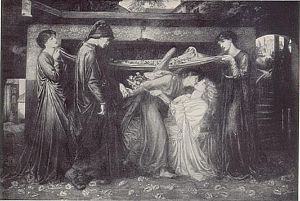
DANTE'S DREAM
[
Reproduced by permission from the original painting in
the possession of the Walker Art Gallery, Liverpool
Note: Blank page.
Note: Blank page.
Note: Blank page.
Note: Blank page.
Note: Blank page.
Note: Blank page.
Note: Blank page.
Note: Blank page.
Note: Blank page.
Note: Blank page.
Note: Blank page.
Note: Blank page.
Note: Blank page.
Note: Blank page.
Note: Blank page.
Note: Blank page.
Note: Blank page.
Note: Blank page.
Note: Blank page.
Note: Blank page.
Note: Blank page.
Note: Blank page.
Note: Blank page.
PERMANENT REPRODUCTIONS OF
THE PAINTINGS AND DRAWINGS
OF DANTE GABRIEL ROSSETTI ARE
PUBLISHED BY FRED K. HOLLYER
9 PEMBROKE SQUARE, KENSINGTON, W.
ILLUSTRATED CATALOGUE 12 STAMPS
Electronic Archive Edition: 1
Source File:
ac-radford.nd497.r8r3.rad.xml

